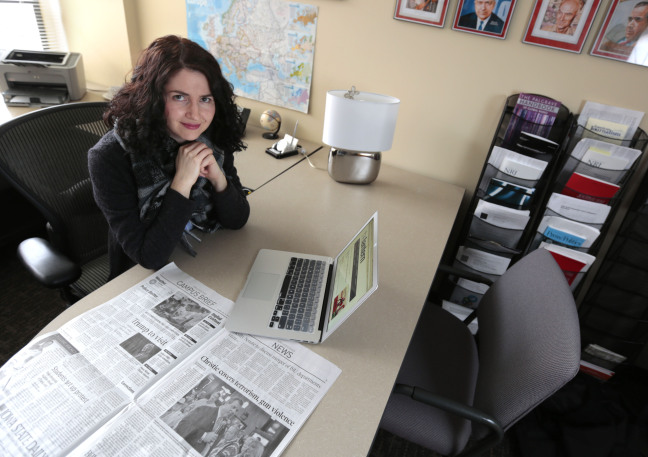
Iowa State's Raluca Cozma says issue-based stories allow voters to make informed decisions. (Larger image) Photo by Christopher Gannon
AMES, Iowa – Voters learn a lot about presidential candidates from the stories they read in the paper or watch on the evening news. How reporters frame those stories as well as the sources they interview can influence voter behavior and perception, said Raluca Cozma, an associate professor in Iowa State University’s Greenlee School of Journalism and Communication.
For that reason, Cozma and Aimee Burch, a former Iowa State graduate student, analyzed coverage of the 2012 presidential election to see how college newspapers compared to mainstream papers. Unlike their professional counterparts, who reported more on political polling and strategy, Cozma and Burch found student journalists focused more on the issues and candidate profiles. The research is published in the Newspaper Research Journal.
“Profiles and issue-based stories allow voters to make a more informed decision,” Cozma said. “We’ve seen a decrease in political interest and participation. I think this type of election coverage is a good recipe to follow to get students engaged, by breaking away from the habitual horse-race framing and trying to make the story relevant to the audience.”
Cozma and Burch collected stories from newspapers at four universities – the University of Colorado, Iowa State University, Ohio State University and the University of North Carolina. They specifically selected papers in swing states, with a larger number of independent or undecided voters, to determine if the papers provided impartial election coverage.
The analysis included 162 articles – 83 percent written by students, 17 percent from wire services – published between the 2012 GOP National Convention and the day after the election. Researchers looked at the sources, story framing (human interest, horserace, etc.) and the tone (positive, negative or neutral) of each story. They found that student reporters included a greater number and variety of sources in their stories and sources relevant to their audiences.
“Student media tend to break away from the norm. They’re more neutral in tone, and they rely on a more diverse pool of sources,” Cozma said. “While they still had access to the candidates or their campaigns, because in all of these states candidates were campaigning aggressively, they also went beyond that and tried to make their stories relate to their audience.”
Cozma found it encouraging that student journalists did not focus only on the usual suspects (students and faculty) for sources, but offered readers a variety of perspectives.
Why the difference?
Cozma acknowledges that the environment and pressures are different for student and professional journalists, which affects the type of coverage. For example, professional journalists may rely more on political polls, because the results are viewed as unbiased and the polls are easy to conduct. However, polling numbers do not help voters make an informed decision, Cozma said. Stories focused on political strategy and polling can also have a negative effect on voters.
“This type of framing tends to build cynicism among audiences and actually make them not turn out to vote, because they see it as a game or as a conflict of strategies,” Cozma said. “Whereas student media relied more on the issues, the policy stances of the candidates, and they tried to explain how those issues relate to students.”
Cozma says this is one of the first college media studies to look specifically at content. She would like to build upon the analysis and encourage other researchers to examine how student journalists cover other important campus issues, such as sexual assault and race. And if there is a lesson for mainstream media to learn from the research, Cozma says it’s to give students a chance.
“People don’t go into journalism to make money; they have a higher calling,” Cozma said. “Allow these students to make a difference by using their tools of the trade, giving them the time and the resources to do their due diligence, because they can make a difference.”
Contacts
Raluca Cozma, Greenlee School of Journalism & Communication, rcozma@iastate.edu, 515-294-0497
Angie Hunt, News Service, amhunt@iastate.edu, 515-294-8986
Quick look
Voters learn a lot about presidential candidates from the stories they read in the paper or watch on the evening news. According to an Iowa State analysis of presidential election coverage, college newspapers focus more on the issues and candidate profiles, while professional papers report more on political polling and strategy.
Quote
“Profiles and issue-based stories allow voters to make a more informed decision. We’ve seen a decrease in political interest and participation. I think this type of election coverage is a good recipe to follow to get students engaged, by breaking away from the habitual horse-race framing and trying to make the story relevant to the audience.”
Raluca Cozma, associate professor in ISU’s Greenlee School of Journalism and Communication